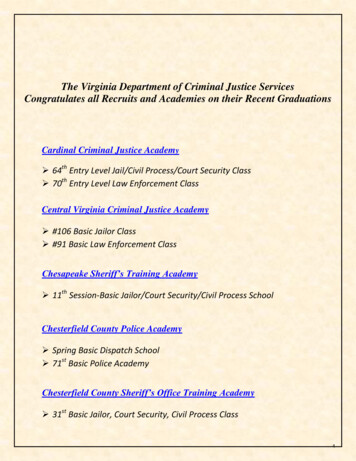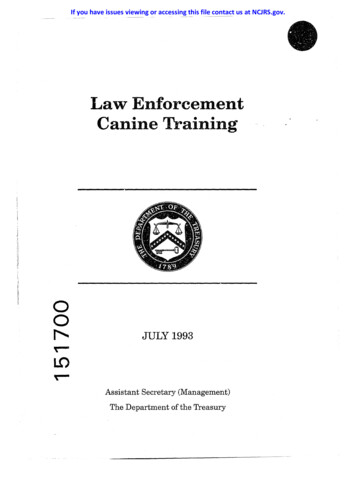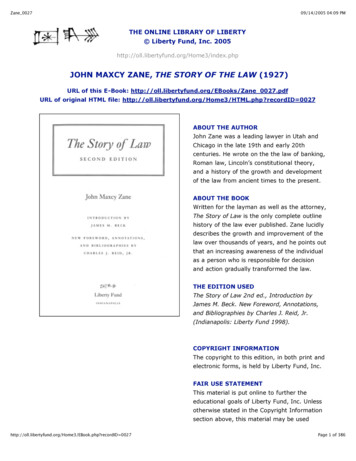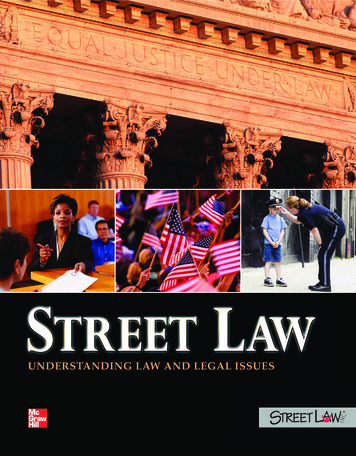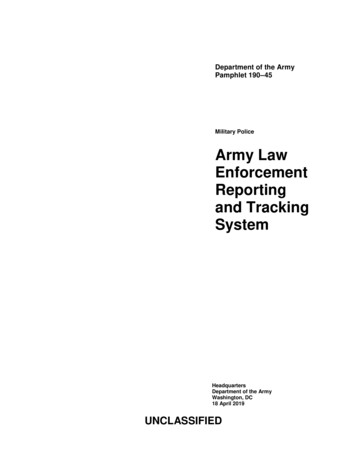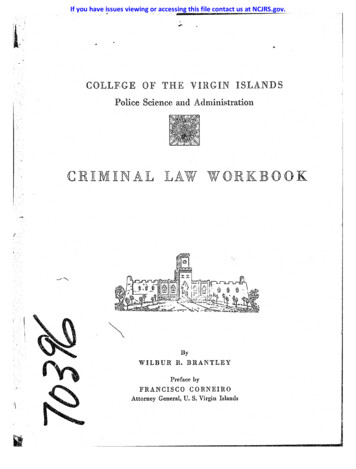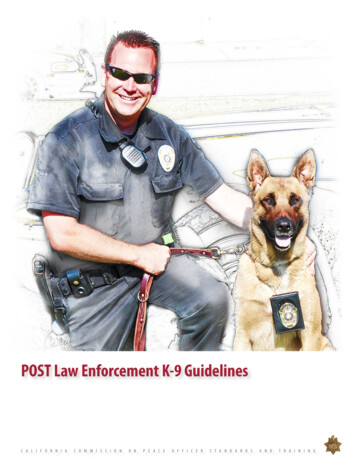
Transcription
POST Law Enforcement K-9 GuidelinesC A L I F O R N I AC O M M I S S I O NO NP E A C EO F F I C E RS T A N D A R D SA N DT R A I N I N G
POST Law Enforcement K-9 GuidelinesProduced byPOST Training Program Services BureauForeword byRobert A. StresakPOST Executive Director
POST Law Enforcement K-9 Guidelines 2014 by California Commission on Peace OfficerStandards and TrainingPublished January 2014All rights reserved. This publication may not bereproduced, in whole or in part, in any form or by anymeans electronic or mechanical or by any informationretrieval system now known or hereafter invented,without prior written permission of the CaliforniaCommission on Peace Officer Standards and Training,with the following exception:California law enforcement agencies in the POSTpeace officer program and POST-certified trainingpresenters are hereby given permission by POSTto reproduce any or all of the contents of thismanual for their internal use.All other individuals, private businesses andcorporations, public and private agencies andcolleges, professional associations, and non-POST lawenforcement agencies in state or out-of-state mayprint or download this information for their personaluse only.Infringement of the copyright protection law and theprovisions expressed here and on the POST websiteunder Copyright/Trademark Protection will be pursuedin a court of law. Questions about copyright protectionof this publication and exceptions may be directed toPublications Manager.All photos used with permission.Special thanks to Chief David M. Brown, Hemet PoliceDepartment.POST2014TPS-0414
POST Mission StatementThe mission of the California Commissionon Peace Officer Standards and Trainingis to continually enhance the professionalismof California law enforcement in servingits communities.LAW ENFORCEMENT CANINE GUIDELINESv
POST CommissionersChairPeter Kurylowicz JrDeputy Sheriff, Riverside CountyVice ChairLaurie SmithSheriff, Santa Clara CountyLai Lai BuiDetective, Sacramento Police DepartmentRonald LowenbergDean, Criminal Justice Training CenterRobert CookeCalifornia Narcotic Officers' AssociationJim McDonnellChief, Long Beach Police DepartmentRobert T. DoyleSheriff, Marin CountySylvia MoirChief, El Cerrito Police DepartmentJoyce DudleySanta Barbara District AttorneyJethroe MoorePublic MemberSandra HutchensSheriff - Coroner, Orange CountyMichael SobekSergeant, San Leandro Police DepartmentLaren LeichliterDeputy, San Bernadino CountyKamala D. HarrisAttorney General, Ex Officio MemberRobert A. StresakPOST Executive DirectorLAW ENFORCEMENT CANINE GUIDELINESvii
AcknowledgementsPOST appreciates the efforts of the 2011-2013 subject matter expert group who assisted inthe development of this voluntary program.Officer Walter AldredSan Leandro Police DepartmentSergeant Romeo IngresoLos Angeles Sheriff’s OfficeOfficer Glen AndersonRialto Police DepartmentChief Dave KeetlePomona Police Department, CPCALieutenant Gary AulisFontana Police DepartmentSergeant Aaron KelliherChino Police DepartmentOfficer John AzevedoSacramento Police Department, PORACOfficer Roger KinneyWest Sacramento Police DepartmentDr. Melissa BainVeterinary Medicine, UC Davis,Communications SupervisorDelia KraftOrange County Sheriff’s Department,PSDACLieutenant Scott BlumModesto Police Department, CNCAMr. Steven BrewerLaw DogsSergeant John KunklePlacerville Police DepartmentMr. Ronnie RackleyFresno County Sheriff’s Office,CAPTOLieutenant Robert RiosLos Angeles World Airports PoliceLieutenant John SavagePlacer County Sheriff’s OfficeAssistant Executive DirectorStephanie ScofieldPOSTLieutenant Barbara UphamCalifornia Highway PatrolLieutenant Dan SeamanCalifornia Highway PatrolMs. Lizelda LopezOgilvy Public Relations,Public MemberDeputy Brian SlominskiVentura County Sheriff’s OfficeSergeant Jay MillerSanta Ana Police DepartmentOfficer Shirley SumnerIrvine Police DepartmentSergeant Don MitchellOntario Police DepartmentOfficer Gregg TawneyElk Grove Police DepartmentCaptain Perry PhippsVisalia Police DepartmentOfficer Diane WardOakland Police DepartmentBureau Chief Bryon GustafsonPOSTSheriff Mike PoindexterModoc County Sheriff’s Office, CSSAOfficer Ernest WolosewiczLong Beach Police DepartmentMr. David InglisInglis Police Dog Academy, CPOAAttorney Bruce PraetFerguson, Praet & ShermanDirector Jared ZwickeySan Joaquin Delta CollegeLieutenant Ron ClowardTop Dog Police K-9 Training andConsulting, WSPCADeputy Tom FaraStanislaus County Sheriff’s DepartmentLieutenant Michael FrawleySan Diego State University PoliceDepartmentLAW ENFORCEMENT CANINE GUIDELINESix
ForewordIn 1991, a group of K-9 Officers, Law Enforcement Managers, and K-9 Trainers fromthroughout the state met to discuss the need for K-9 Team Standards in California. Thegroup believed that local liability would be reduced if statewide K-9 Team Standards wereavailable. They further believed that these standards, to be acceptable and have impact,should be supported by the Commission on Peace Officer Standards and Training (POST).In February 1992, POST brought this committee and other interested experts together,and they agreed to develop guidelines in the area of Obedience, Search, Apprehension,Handler Protection, Handler Selection, and Evaluation. After initial development workand following several reviews which resulted in consensus, the proposed guidelines weresubmitted to and approved by the POST Commission in July 1992.Following Commission action, POST brought the subject matter experts togetheragain and developed suggested scenarios to test the recommended minimum K-9Team Standards contained within the approved guidelines. POST developed a one-dayEvaluator’s Course and accompanying evaluation forms to train officers evaluating K-9Teams.This update, developed between November 2011 and October 2013, aims to refine andstreamline the guidelines which were in use for more than a decade. POST recognizedthat agencies utilize K-9 teams in various capacities and with differing expectations.Additionally, many more specialized K-9 team functions have developed in the twodecades since POST first created the guidelines. As a result, POST determined it wouldnot attempt to comprehensively standardize all functions. Instead, these guidelinesrecommend minimum training and evaluation benchmarks for K-9 Patrol and Detectionfunctions. They are for the voluntary use of law enforcement agencies and are sufficientlygeneral to accommodate differing agencies’ policies regarding operational deployment ofK-9 teams.Questions regarding the POST Law Enforcement K-9 Guidelines should be directed to theTraining Program Services Bureau at 916 227-4885. Questions regarding certification of K-9training courses should be directed to the Training Delivery and Compliance Bureau at 916227-4863.Robert A. StresakPOST Executive DirectorLAW ENFORCEMENT CANINE GUIDELINESxi
IntroductionThese guidelines are designed to assist agencies with minimum training and performancestandards for patrol and detection K-9 teams. Patrol K-9 teams should meet minimumstandards with regard to obedience, search, apprehension, and handler protection.Detection K-9 teams should meet minimum standards with regard to detections of theodor(s) the K-9 is trained to detect.This categorization (patrol and detection) is intentionally basic. POST recognizes thatthere are many specializations among law enforcement canines. Specializations includeexplosives detection, cadaver detection, search and rescue, SWAT, and airport operations,among others. There are many resources and industry standards that may be relevantand useful to agencies engaged in these or other K-9 specialties. Many are identified inAppendix 3 – Resources.LAW ENFORCEMENT CANINE GUIDELINESxiii
ContentsPOST Mission Statement . vPOST Commissioners . viiAcknowledgements . ixForeword . xiIntroduction . xiiiTraining Guidelines .1Patrol Guidelines.1Detection Guidelines.2Scenarios for K-9 Team Evaluation .3K-9 Team Evaluation .7K-9 Team Evaluator’s Course (8 hours) .9Appendix 1 Glossary. 13Appendix 2 Evaluation Forms. 15Obedience. 16Search. 17Apprehension. 18Handler Protection. 19Detection. 20Appendix 3 Resources. 21LAW ENFORCEMENT CANINE GUIDELINESxv
Training GuidelinesPOST has not established a recommended minimum standard for basic K-9 handler/teamtraining.POST recommends that an in-service K-9 team complete 16 hours of documented trainingmonthly to maintain basic patrol and/or detection proficiency.A K-9 team with multiple/added specializations (e.g., SWAT K-9, bomb detection, searchand rescue) may require additional training to maintain proficiency.Patrol GuidelinesThe following four K-9 team competencies outline minimum “patrol” performancestandards that a K-9 team should be able to demonstrate when adopting these voluntaryguidelines.1. ObedienceThe handler will demonstrate the ability to control the K-9 during an obedienceperformance test. Testing will be conducted using reasonable job-relateddistractions.1.1. The K-9 will perform a basic routine of left, right, and about turns, at slow,normal, and quick pace, both on and off leash.1.2. The handler will “down” the K-9 in motion and then recall the dog to a “heel”position from a distance.1.3. The handler will “down” the K-9 from a distance and then recall the dog to a“heel” position.2.SearchUnder the direction and reasonable control of the handler, the K-9 willindependently locate a hidden person in a structure or building and in an outdoorarea within a reasonable period of time. The dog will “alert” the handler afterfinding the person. The “alert” will be a recognized signal from the dog to thehandler which indicates the presence of a hidden person. The handler will notifythe evaluator of the recognizable signal prior to testing.2.1. In a structure or building with multiple rooms and hiding places, the dog willlocate a hidden person and “alert” the handler.2.2. In a large outdoor area, at least one acre in size with multiple hiding locations,the dog will locate a hidden person and “alert” the handler.LAW ENFORCEMENT CANINE GUIDELINES1
COMMISSION ON PEACE OFFICER STANDARDS AND TRAINING3. ApprehensionUnder the direction of the handler and while off leash, the K-9 will pursue andapprehend a person acting as a “suspect” (agitator/decoy).3.1. The K-9 team will demonstrate a pursuit and call off prior to apprehension.3.2. On command from the handler, the K-9 will pursue and apprehend theagitator/decoy.3.3. From a reasonable distance and on verbal command only, the K-9 will ceasethe apprehension.4. Handler ProtectionThe K-9 will demonstrate the ability to defend the handler during a physical attack.4.1. During a testing scenario simulating an attack on the handler, the K-9 willdefend the handler against the physical attack.4.2. On verbal command from the handler, the K-9 will cease physical contact withthe attacking person.Detection GuidelinesThe following K-9 team competency outlines minimum “detection” performance standardsthat a K-9 team should be able to demonstrate when adopting these voluntary guidelines.SearchWhile demonstrating reasonable control and coordination between the handler and K-9used in detection, the K-9 must find (within a reasonable period of time as determined bythe evaluator) the odor(s) they have been trained to find in the environment(s) they havebeen trained to search.1. The K-9 should not “alert” to anything that it is not trained to find2. A false “alert” (as determined by the evaluator) is a failure2
Scenarios for K-9 Team EvaluationFollowing are scenarios for K-9 team evaluation in each of the competency areas. Thesescenarios contain minimum elements for evaluation.ObedienceThe evaluator will be fully apprised of the pertinent agency policies and regulations priorto commencement of the exercise. The “correct” response or reaction of the handler, thedog, or the two acting together, may differ from agency to agency, based on prevailingagency policy.Handlers will report to the evaluator with the dog on a leash. At the direction of theevaluator, the team will complete the following exercises as called for by the evaluator.During the exercise the dog will be under the handler’s control at the “heel” position.At the “forward” direction of the evaluator, handlers will proceed ahead with their dogsat the “heel” position and at a slow, normal, and/or quick pace at the direction of theevaluator. The evaluator will direct the handler-canine team through a series of turns andmovements including the following:1. On leash:1.1. Two right turns1.2. Two left turns1.3. Two about-turns1.4. Two stop/sits2. Off leash (with distraction):2.1. Two right turns2.2. Two left turns2.3. Two about-turns2.4. Two stop/sits2.5. Down in motion:While continuing forward at a quick pace, the handler will “down” the dogon the evaluator’s command and continue to jog forward until reaching adesignated point (at least 30 paces away). The handler will then turn and facethe dog. At the evaluator’s command, the handler will recall the dog to theirlocation by means of voice and/or hand signal(s) to finish “heel” position.LAW ENFORCEMENT CANINE GUIDELINES3
COMMISSION ON PEACE OFFICER STANDARDS AND TRAINING2.6. With the dog in stand/stay or sit/stay position:The handler, from a location at least 30 paces away, will face the dog, waitfor the evaluator’s command, then “down” the dog by means of voice and/orhand signals. The handler will then recall the dog upon the command of theevaluator.The obedience exercises should be conducted in an environment closely simulatingrealistic job conditions and distractions.SearchThe evaluator will be fully apprised of the pertinent agency policies and regulations priorto commencement of the exercise. The “correct” response or reaction of the handler, thedog, or the two acting together, may differ from agency to agency, based on prevailingagency policy.Upon command of the evaluator, the K-9 team will approach the designated search areaon foot. At the handler’s direction and command, the dog shall actively and independentlysearch the test area until the decoy is located or the evaluator terminates the exercise.There should be a recognized signal (“alert”) from the dog to the handler which indicatesthat the dog has located a hidden person. The handler must be able to interpret the dog’s“alert” clearly enough to be able to inform the evaluator of the decoy’s actual location.Once a handler has signaled the “alert” of their K-9 to the evaluator, the exercise iscomplete. The handler should demonstrate the ability to control the dog fully throughoutall phases of the search.Apprehension (without contact)The evaluator will be fully apprised of the pertinent agency policies and regulations priorto commencement of the exercise. The “correct” response or reaction of the handler, thedog, or the two acting together, may differ from agency to agency, based on prevailingagency policy.The K-9 team will begin the exercise “off-leash” from a designated starting position. Thehandler will ensure that the dog remains with them and may hold the dog’s collar ifneeded. Upon the evaluator’s signal, a person acting as a “suspect” (agitator/decoy) willpresent himself visually at a reasonable distance (25-30 yards) from the K-9 team andbegin running away. The handler will verbally order the “suspect” to stop. The “suspect”will ignore the order and continue flight. The handler will then send the dog in pursuitof the suspect and may join in the pursuit to ensure full view of the dog and “suspect.”Allowing a reasonable distance (20-30 yards), the “suspect” will stop in mid-flight at theevaluator’s command and stand still. When the dog is approximately half way to the decoy,the handler will verbally order the dog to abandon the apprehension. The dog must notphysically contact the decoy after the “call off” command from the handler.4
Apprehension (with contact)The evaluator will be fully apprised of the pertinent agency policies and regulations priorto commencement of the exercise. The “correct” response or reaction of the handler, thedog, or the two acting together, may differ from agency to agency, based on prevailingagency policy.This exercise will duplicate the above procedure, except in this scenario the agitator/decoywill not stop and the handler will send the dog to pursue, contact, and apprehend theagitator/decoy. The handler may join in the pursuit. The dog will contact and control theagitator/decoy until called off by the handler.During the apprehension and on verbal command only from the handler, the dog willdisengage the contact.Handler ProtectionThe evaluator will be fully apprised of the pertinent agency policies and regulations priorto commencement of the exercise. The “correct” response or reaction of the handler, thedog, or the two acting together, may differ from agency to agency, based on prevailingagency policy.The handler approaches an individual (agitator/decoy) standing nearby and initiates a fieldinterview contact. After approximately 30 seconds the agitator/decoy suddenly physicallyassaults the handler. The dog should react to the attack by either of the following actions:1. “Conditioned” defense of handler, no command given;2. Respond when called upon by the handler’s verbal command.The dog will defend the handler by making physical contact with the agitator/decoy. Thedog must disengage upon a verbal command by the handler. Upon release, the dog willremain under control of the handler.DetectionThe evaluator will be fully apprised of the pertinent agency policies and regulations priorto commencement of the exercise. The “correct” response or reaction of the handler, thedog, or the two acting together, may differ from agency to agency, based on prevailingagency policy.While demonstrating reasonable control and coordination between the handler and K-9used in detection, the K-9 must find—within a reasonable period of time—the odor(s)identified.There should be a recognized signal “alert” from the dog to the handler which indicatesthat the dog has located each odor. The handler must be able to interpret the dog’s “alert”clearly enough to be able to inform the evaluator of the substance’s location. Once ahandler has signaled their canine’s “alert” to the evaluator, the exercise is complete.LAW ENFORCEMENT CANINE GUIDELINES5
COMMISSION ON PEACE OFFICER STANDARDS AND TRAININGThe handler must demonstrate the ability to control the dog fully throughout all phases ofthe search.The evaluation should contain at least one blank oder in each environment evaluated.To ensure adequate scent dispersion, setup time for each sample should be a minimum of30 minutes prior to the actual search.The actual target odor should be present for the evaluation.6
K-9 Team EvaluationThe K-9 Team should be evaluated by a POST-trained evaluator prior to general lawenforcement deployment and at least once annually.Minimum requirements for law enforcement K-9 evaluators:1. Should have a minimum of five years experience as a Law Enforcement K-9 Handleror Law Enforcement K-9 Trainer, and a minimum of 200 hours of documentedtraining in the area they are evaluating.2. Should pass a POST-certified K-9 Team Evaluator’s Course. (Trainees in the coursemust provide verification of prerequisites to the course presenter prior to thebeginning of the course.)3. In order to preserve the highest standards of professionalism and to avoid anyperceived conflict of interest between the Evaluator and the K-9 Team, the Evaluator:3.1. Should not have a monetary interest in breeding/selling/training of the dogbeing evaluated.3.2. Should not be the handler of the dog being evaluated.LAW ENFORCEMENT CANINE GUIDELINES7
K-9 Team Evaluator’s Course (8 hours)Objectives1. Train students to evaluate a K-9 team’s performance under POST guidelines.2. Train students how to interpret and apply a reasonable and uniform evaluation ofstandards set forth in POST guidelines for patrol and detection dogs.3. Conduct an evaluation as a final test. At course completion, students must havedemonstrated the ability to properly apply POST K-9 team guidelines in theevaluation process to the course provider’s satisfaction.Expanded Course Outline1. Introduction1.1. Objectives1.2. Overview of course1.3. Review POST Law Enforcement K-9 Guidelines2. Demonstration2.1. Demonstrate a K-9 team completing scenarios that meet recommendedguidelines.3. Scenarios (take into account agency differences)3.1. Equipment3.1.1. Use actual field equipment deployed by agency being evaluatedthroughout the testing process.3.1.1.1. Dog3.1.1.2. Handler3.1.1.3. Training3.1.1.4. Materials needed for evaluation (narcotic aids, etc.)3.2. Use of agitators/decoys3.2.1. Agency being tested should provide agitators/decoys to work underdirection of the evaluator.LAW ENFORCEMENT CANINE GUIDELINES9
COMMISSION ON PEACE OFFICER STANDARDS AND TRAINING3.2.2. Evaluator to provide clear directions3.2.3. Consistency among decoys/agitators3.3. Site selection3.3.1. Select area conducive to testing3.3.2. Tested agency selects site, subject to approval of evaluator3.4. Reasonable test conditions3.4.1. All testing scenarios should be designed to reasonable workingconditions3.4.2. Extreme testing situations should be avoided (e.g., inclement weather)3.5. Safety considerations3.5.1. Apply POST Specific Safety Policy for K-9 training. (Note: SafetyPolicy must be submitted and approved by POST prior to coursecertification.)3.5.2. Plan for officer first aid3.5.3. Plan for K-9 first aid4. Uniform application of standards4.1. Definition of terms4.1.1. Reference POST Law Enforcement K-9 Guidelines4.2. POST guidelines4.2.1. These are not the evaluator’s guidelines. Evaluator should not add/subtract from testing guidelines.5. Local considerations5.1. Prior to testing5.1.1. The evaluator should become familiar with the agency’s policies,procedures, and standards.5.1.2. The evaluator should know, prior to testing, what field equipment isnormally used by the agency.5.2. During evaluation process5.2.1. The evaluator should make reasonable accommodations to theagencies’ K-9 team being tested without deviating from POSTguidelines.5.2.2. Test only those topics within the guidelines that are applicable to theagency being evaluated.10
6. Testing6.1. How to use the scenarios6.1.1. Refer to Scenarios for K-9 Team Evaluation6.2. Evaluator’s discretion6.2.1. Minor mistakes (second commands, etc.)6.2.2. Reasonable time6.2.3. Test termination6.2.4. Time given/needed before a retest6.3. Failure of test6.3.1. Retest only the major topic failed6.3.2. Failure of any required portion of detection evaluation necessitates aretest for that portion of the evaluation.7. Evaluation forms7.1. How to use forms7.2. Use comments section only if there is a failure7.2.1. Write brief comments7.2.2. Avoid training recommendations7.3. Signed evaluation forms are to be left with the agency being evaluated.7.4. Indicate on the evaluation form the type of agency equipment used duringthe testing process.7.5. Describe environment of evaluation (e.g., vehicle, plane, field, building, etc.).8. Reasonable application of POST guidelines8.1. Do not dictate agency policy8.2. Work within agency policyLAW ENFORCEMENT CANINE GUIDELINES11
Appendix 1GlossaryAlertA recognized signal from the dog to the handler.BlankThe absence of the target odor.Call OffA voice command, from handler to dog, which results in the dog ceasing an activity.Field Equipment The equipment used by the dog or the handler while performing normal duties.HandlerThe person that deploys the dog as part of the K-9 team.LAW ENFORCEMENT CANINE GUIDELINES13
Appendix 2Evaluation FormsThe forms on the following pages are samples/templates for agency use/modification.They indicate basic data elements that should be documented during K-9 team evaluation.Click the thumbnail to go to a full sized version; click the download button for an editableWord version, and click the pencil button for a fillable version.ApprehensionObedienceSearchHandler ProtectionDetectionLAW ENFORCEMENT CANINE GUIDELINES15
River City Police Department K-9 Team EvaluationObedienceDate/ /Critical Tasks: Obedience and Control of K-9HandlerK-9EvaluatorEvaluator signatureLocationEquipment1. On leashSlowNormalQuickLeft turnRight turnAbout turn Left turnRight turnAbout turn 2. Off leashSlowNormalQuick3. Down in motionSlowNormalQuickDown/stayRecallFinish 4. Down from a distanceSlowNormalQuickPassFail Stand/sitSitDownRecallFinish DistractionsComments16
River City Police Department K-9 Team EvaluationSearchCritical Tasks: Reasonable Control, Suspect Location, Signal r signatureLocationEquipment1. Building searchPassFail ControlLocateRecognitionReasonable search time 2. Outdoor search ControlLocateRecognitionReasonable search time CommentsLAW ENFORCEMENT CANINE GUIDELINES17
River City Police Department K-9 Team EvaluationApprehensionCritical Tasks: Control, Pursuit, Call OffDate/ /HandlerK-9EvaluatorEvaluator signatureLocationEquipment1. Apprehension without contactControl PassFail Pursuit on command Call off without contact 2. Apprehension with contactControlPursuit on commandContactCall off 3. Call off Control 4. DisengageControl Comments18
River City Police Department K-9 Team EvaluationHandler ProtectionCritical Tasks: The dog makes physical contact with the agitator/decoy, the dog“disengages” on verbal command, the dog remains under control.Date/ /HandlerK-9EvaluatorEvaluator signatureLocationEquipmentPassFail1. Physical Contact 2. Call Off 3. Remains Under Control CommentsLAW ENFORCEMENT CANINE GUIDELINES19
River City Police Department K-9 Team EvaluationDetectionCritical Tasks: Reasonable control, find r signatureLocationEquipment1. Building searchPassFail Substances detected:2. Vehicle searchSubstances detected:3. Outside area searchSubstances detected:4. Other area search (describe in Comments)Substances detected:Comments20
Appendix 3ResourcesThe following resources provide potentially valuable information relating to lawenforcement K-9 training. Not all content has been reviewed. Sources listed here arerecognized for their subject matter, but are not specifically endorsed by POST.California Narcotic Canine Associationhttp://cnca.com/home/International Working Dog Breeding Associationhttp://www.iwdba.org/National Police Bloodhound Associationhttp://www.npba.com/National Police Canine Associationhttp://www.npca.net/National Narcotic Detector Dog Associationhttp://www.nndda.org/North American Police Work Dog Associationhttp://www.napwda.com/Penn Vet Working Dog Centerhttp://pennvetwdc.org/Scientific Working Group on Dog and Orthogonal Detector Guidelineshttp://swgdog.fiu.edu/United States Police Canine Associationhttp://www.uspcak9.com/Western States Police Canine Associationhttp://www.wspca.net/LAW ENFORCEMENT CANINE GUIDELINES21
training. POST recommends that an in-service K-9 team complete 16 hours of documented training monthly to maintain basic patrol and/or detection proficiency. A K-9 team with multiple/added specializations (e.g., SWAT K-9, bomb detection, search and rescue) may require addi



